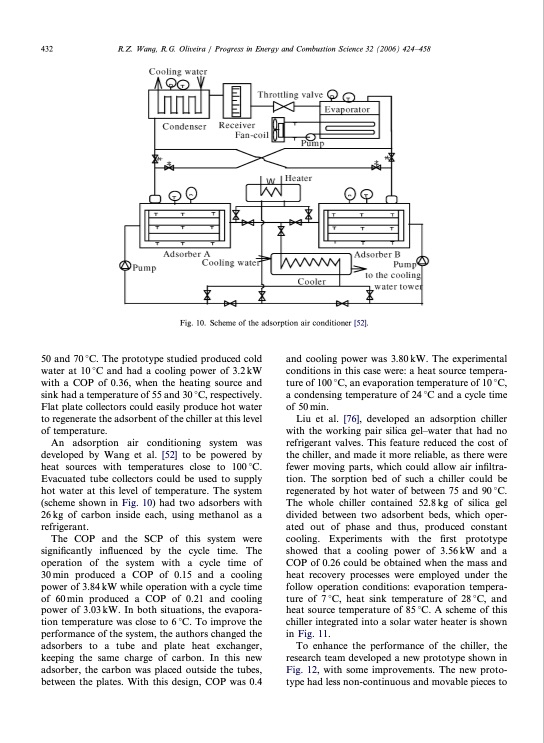
PDF Publication Title:
Text from PDF Page: 009
ARTICLE IN PRESS 432 R.Z. Wang, R.G. Oliveira / Progress in Energy and Combustion Science 32 (2006) 424–458 Fig. 10. Scheme of the adsorption air conditioner [52]. 50 and 70 1C. The prototype studied produced cold water at 10 1C and had a cooling power of 3.2 kW with a COP of 0.36, when the heating source and sink had a temperature of 55 and 30 1C, respectively. Flat plate collectors could easily produce hot water to regenerate the adsorbent of the chiller at this level of temperature. An adsorption air conditioning system was developed by Wang et al. [52] to be powered by heat sources with temperatures close to 1001C. Evacuated tube collectors could be used to supply hot water at this level of temperature. The system (scheme shown in Fig. 10) had two adsorbers with 26kg of carbon inside each, using methanol as a refrigerant. The COP and the SCP of this system were significantly influenced by the cycle time. The operation of the system with a cycle time of 30min produced a COP of 0.15 and a cooling power of 3.84 kW while operation with a cycle time of 60min produced a COP of 0.21 and cooling power of 3.03 kW. In both situations, the evapora- tion temperature was close to 6 1C. To improve the performance of the system, the authors changed the adsorbers to a tube and plate heat exchanger, keeping the same charge of carbon. In this new adsorber, the carbon was placed outside the tubes, between the plates. With this design, COP was 0.4 and cooling power was 3.80 kW. The experimental conditions in this case were: a heat source tempera- ture of 100 1C, an evaporation temperature of 10 1C, a condensing temperature of 24 1C and a cycle time of 50 min. Liu et al. [76], developed an adsorption chiller with the working pair silica gel–water that had no refrigerant valves. This feature reduced the cost of the chiller, and made it more reliable, as there were fewer moving parts, which could allow air infiltra- tion. The sorption bed of such a chiller could be regenerated by hot water of between 75 and 90 1C. The whole chiller contained 52.8kg of silica gel divided between two adsorbent beds, which oper- ated out of phase and thus, produced constant cooling. Experiments with the first prototype showed that a cooling power of 3.56kW and a COP of 0.26 could be obtained when the mass and heat recovery processes were employed under the follow operation conditions: evaporation tempera- ture of 7 1C, heat sink temperature of 28 1C, and heat source temperature of 85 1C. A scheme of this chiller integrated into a solar water heater is shown in Fig. 11. To enhance the performance of the chiller, the research team developed a new prototype shown in Fig. 12, with some improvements. The new proto- type had less non-continuous and movable pieces toPDF Image | Adsorption refrigeration

PDF Search Title:
Adsorption refrigerationOriginal File Name Searched:
2008519283773463.pdfDIY PDF Search: Google It | Yahoo | Bing
NFT (Non Fungible Token): Buy our tech, design, development or system NFT and become part of our tech NFT network... More Info
IT XR Project Redstone NFT Available for Sale: NFT for high tech turbine design with one part 3D printed counter-rotating energy turbine. Be part of the future with this NFT. Can be bought and sold but only one design NFT exists. Royalties go to the developer (Infinity) to keep enhancing design and applications... More Info
Infinity Turbine IT XR Project Redstone Design: NFT for sale... NFT for high tech turbine design with one part 3D printed counter-rotating energy turbine. Includes all rights to this turbine design, including license for Fluid Handling Block I and II for the turbine assembly and housing. The NFT includes the blueprints (cad/cam), revenue streams, and all future development of the IT XR Project Redstone... More Info
Infinity Turbine ROT Radial Outflow Turbine 24 Design and Worldwide Rights: NFT for sale... NFT for the ROT 24 energy turbine. Be part of the future with this NFT. This design can be bought and sold but only one design NFT exists. You may manufacture the unit, or get the revenues from its sale from Infinity Turbine. Royalties go to the developer (Infinity) to keep enhancing design and applications... More Info
Infinity Supercritical CO2 10 Liter Extractor Design and Worldwide Rights: The Infinity Supercritical 10L CO2 extractor is for botanical oil extraction, which is rich in terpenes and can produce shelf ready full spectrum oil. With over 5 years of development, this industry leader mature extractor machine has been sold since 2015 and is part of many profitable businesses. The process can also be used for electrowinning, e-waste recycling, and lithium battery recycling, gold mining electronic wastes, precious metals. CO2 can also be used in a reverse fuel cell with nafion to make a gas-to-liquids fuel, such as methanol, ethanol and butanol or ethylene. Supercritical CO2 has also been used for treating nafion to make it more effective catalyst. This NFT is for the purchase of worldwide rights which includes the design. More Info
NFT (Non Fungible Token): Buy our tech, design, development or system NFT and become part of our tech NFT network... More Info
Infinity Turbine Products: Special for this month, any plans are $10,000 for complete Cad/Cam blueprints. License is for one build. Try before you buy a production license. May pay by Bitcoin or other Crypto. Products Page... More Info
| CONTACT TEL: 608-238-6001 Email: greg@infinityturbine.com | RSS | AMP |